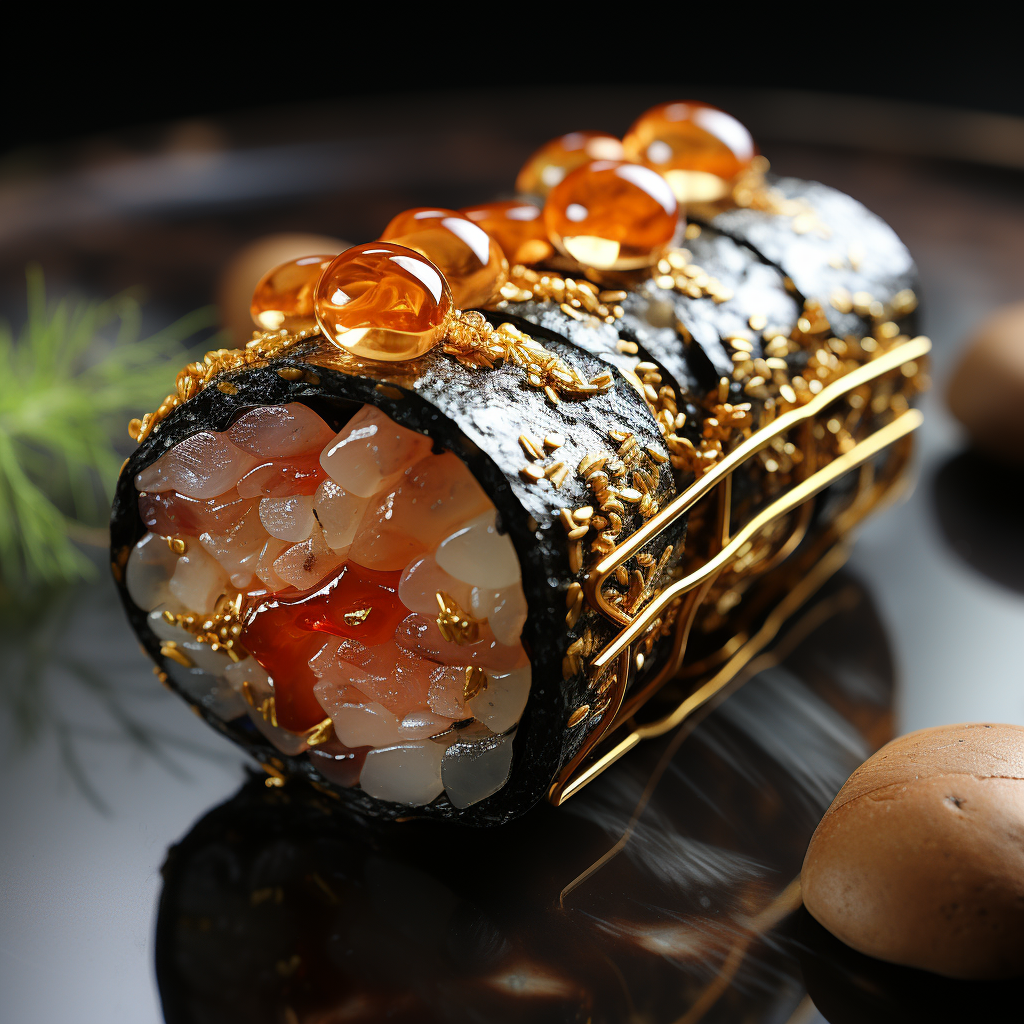ELI5 Summary:
“Sushi’s high price can be attributed to several key factors. Firstly, sushi’s rich history and the meticulous craftsmanship required to create these bite-sized delicacies justify the cost. Notably, the cost of high-grade ingredients, especially premium fish variants, significantly inflates the overall sushi price. Additionally, proper handling and preparation of these ingredients, which demand precision and expertise, contribute to the expense. Beautiful presentation following the Japanese aesthetic philosophy adds to sushi’s value as well. Finally, market dynamics, including increased demand and supply shortages, have a notable effect on the cost of sushi. While these factors do contribute to higher sushi prices, it’s worth noting that there are also affordable options available for sushi lovers.”
Introduction: Why is Sushi so Expensive?
Ever find yourself asking, “why is sushi so expensive?” Sushi seems to be a food category all on its own when it comes to pricing. What if we told you that those tiny, delicious rolls are more than just a meal—they’re a captivating mix of culinary history, artistry, and intricate handling? In this blog, we explore all these captivating facets and uncover why sushi often comes with a hefty price tag.
The History of Sushi
Origins of Sushi
Sushi, now renowned as a delicacy around the globe, had humble beginnings in Southeast Asia. Its initial conception was for far more practical purposes than satisfying our gourmet cravings—it was a method of preserving fish in fermented rice. Interestingly, the rice, tainted with the taste of fermentation, was discarded, and only the preserved fish was consumed.
The Transformation of Sushi over the Centuries
Over centuries, sushi evolved intricately. It journeyed from being a preservation technique in 7th century Japan to being a fast food sold at sushi stalls in the Edo era (1603-1868). However, it was in the early 19th century that sushi began to resemble the bite-sized pieces we’re familiar with today. A sushi chef named Hanaya Yohei is credited with this transformation, introducing raw fish atop vinegared rice, taking into account not just the taste, but the aesthetics of the dish. Consequently, sushi grew from a practical solution to a symbol of Japanese aesthetics and culinary finesse, playing a big role in the price it commands today.
The Intricate Process of Making Sushi
The hefty price tag attached to sushi isn’t just about its rich history; it reflects the complexity behind its creation. Understanding the art of sushi-making will make the bills seem less daunting and more of a tribute to the craftsmanship.
Handling and Preparing the Fish
A significant portion of sushi’s cost lies in the fish. Sushi chefs must spend years mastering the skills needed to correctly clean, fillet, and slice the fish. It’s not simply cutting up fish; it’s a delicate, meticulous process. Adding more to the complexity, the types of fish used in sushi—tuna, salmon, yellowtail—are often high-cost species. The fish must also be extremely fresh. We’re talking caught-today-fresh to maintain the flavour and texture sushi connoisseurs expect.
Sourcing and Cooking the Rice
At first glance, sushi rice may not seem special. However, it’s no ordinary rice. Sushi demands short-grain Japanese rice known for its characteristic sticky texture when cooked. Achieving this texture—soft yet firm with individual grains distinguishable—is an art form. Furthermore, the rice must be seasoned flawlessly with the just right combination of vinegar, sugar, and salt, adding to the intricacy and cost.
Constructing the Roll
Ever noticed how neatly your sushi is constructed? Each piece is the same size, the rice uniformly compacted, and the fillings enticingly arranged. This is a skill that demands precision, finesse, and a whole lot of practice. The balance of filling to rice needs to be perfect. Too much filling and the roll falls apart, too little and you’re left underwhelmed. Achieving this balance consistently isn’t anything short of a culinary ballet and significantly contributes to why sushi is so expensive.
The Cost of Ingredients
Along with the effort and mastery shaping sushi, the ingredients used play a significant role in the final price. Each element, from the fish and rice to the nori, is chosen for its quality, freshness, and relevance.
Exorbitant Price of High-Quality Fish
The fish used in sushi is typically sourced from premium, often exotic, varieties. These types of fish – like the bluefin tuna – can get quite expensive. Some sushi chefs even compete at auctions for the top catch of the day, leading to incredibly high prices. For instance, a bluefin tuna once sold for a record-breaking $3.1 million at Tokyo’s new fish market!
Ensure Freshness & Safety
Sushi chefs are incredibly particular about the freshness of their fish. After all, most sushi includes raw fish, which needs to be impeccably fresh to ensure a superb taste and safe consumption. Such high standards of freshness often mean source fish daily, contributing to higher costs. Maintaining the cold chain, ensuring safety measurements, and meeting hygiene standards add to the expenses as well, pushing up the final price of sushi.
Cost of Sushi Rice and Nori
While rice and nori (seaweed used to wrap sushi) might seem like minor components in a sushi roll, they’re pivotal to the overall taste and texture, and sushi chefs don’t compromise on their quality. Sushi-grade rice, known for its unique combination of taste, texture, and stickiness, comes with higher costs than your everyday rice. Fresh, high-quality nori, with its characteristic flavor and crispiness, is expensive as well, contributing significantly to the overall cost of sushi-making.
The Artistry Behind Sushi
Then there’s the aesthetic element—the presentation. Sushi isn’t just food; it is a form of artistic expression and cultural tradition that commands respect—and, subsequently—higher prices.
Mastery and Skill
Perfecting the art of sushi takes more than just a knack for flavours. It requires significant finesse, precision, and years of training. In Japan, aspiring sushi chefs spend years under the tutelage of masters to learn the complex choreography of creating the perfect sushi. Some chefs spend up to 10 years before they are even allowed to prepare the sushi rice! This dedication, time, and energy results in sushi that’s more than just a meal—it’s an experience. The cost of sushi, therefore, isn’t just for the taste but also for the mastery and skill that goes into each roll.
Appreciation for Aesthetics
Ever marveled at the beautiful presentation of your sushi platter? The arrangement of colours, the precision of the cut, and even the placement of garnishes—it all comes together to create a feast for the eyes. This attention to aesthetics follows the Japanese philosophy of celebrating beauty in everyday objects and tasks. Sushi, in this spirit, is presented as a miniature work of art. The pricing then becomes about appreciating this art and craft as much as it is for the taste and satiety.
How the Market Influences Sushi Prices
Another key factor influencing sushi prices is market dynamics. This includes supply and demand, consumer preferences, and even environmental concerns, among other things.
Supply and Demand Complexities
When it comes to in-demand sushi fish like bluefin tuna, supply can’t always keep up with the high demand, pushing prices higher. Furthermore, apprehensions regarding overfishing and the sustainability of certain fish stocks have led to fishing quotas and bans on certain species, thus limiting supply and driving up costs.
Impact of Consumer Tastes and Preference
Consumer preferences also play a vital role when it comes to sushi pricing. The increasing popularity of sushi means higher demand. Additionally, as people become more adventurous with their palates, there’s an increasing appetite for more unique and exotic sushi creations. This leads chefs to source rare and premium ingredients, which inevitably increases the price. Want to try that lobster or caviar sushi? Be prepared to shell out some extra bucks!
Exceptions to the Rule: Affordable Sushi Options
Despite the factors adding to the high cost of sushi, you don’t always have to break the bank to enjoy this delicacy. There are options out there for budget-friendly sushi enjoyment.
Pre-packaged Sushi
Pre-packaged sushi from supermarkets or convenience stores often comes with a much smaller price tag. While they might not offer the same freshness or quality as a sushi restaurant, they can still be an enjoyable option for a quick sushi fix.
Cheap Eateries and Conveyor Belt Sushi Options
Around the world, there are eateries offering sushi at lower prices. Of particular note in Japan are kaiten-zushi, or conveyor belt sushi restaurants, where customers can pick and choose from circulating plates of sushi. Here, pricing is often based on the color of the plate you select. These types of eateries generally offer sushi at lower prices due to the higher volume and quick turnaround.
Conclusion: The True Value of Sushi
As we’ve journeyed through the history, creativity, mastery, and market dynamics that make sushi what it is, it becomes clear why sushi often comes with a higher price tag. It’s more than just raw fish on rice—it’s an embodiment of a culture, a tradition, a craft, and an art. So, the next time you sit down to enjoy your sushi, you’ll appreciate it not just for its taste but for everything it represents. And that, no doubt, is priceless.




